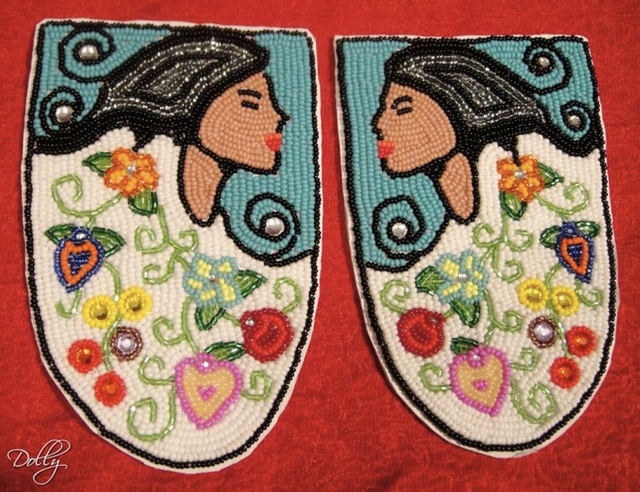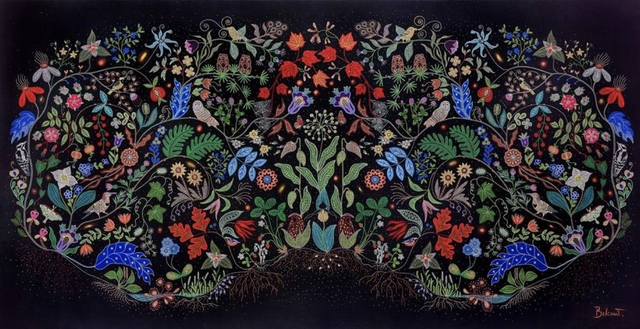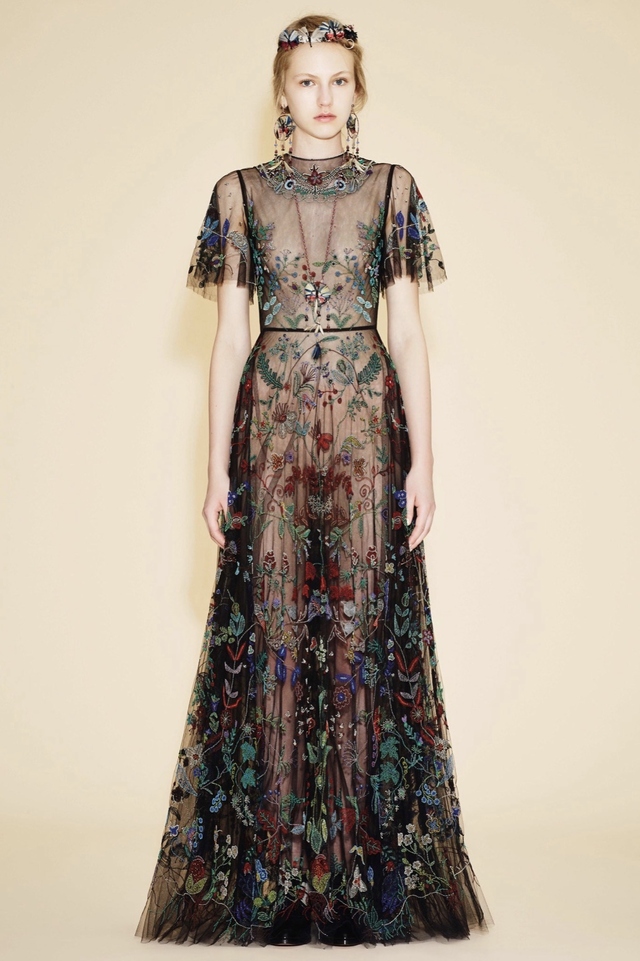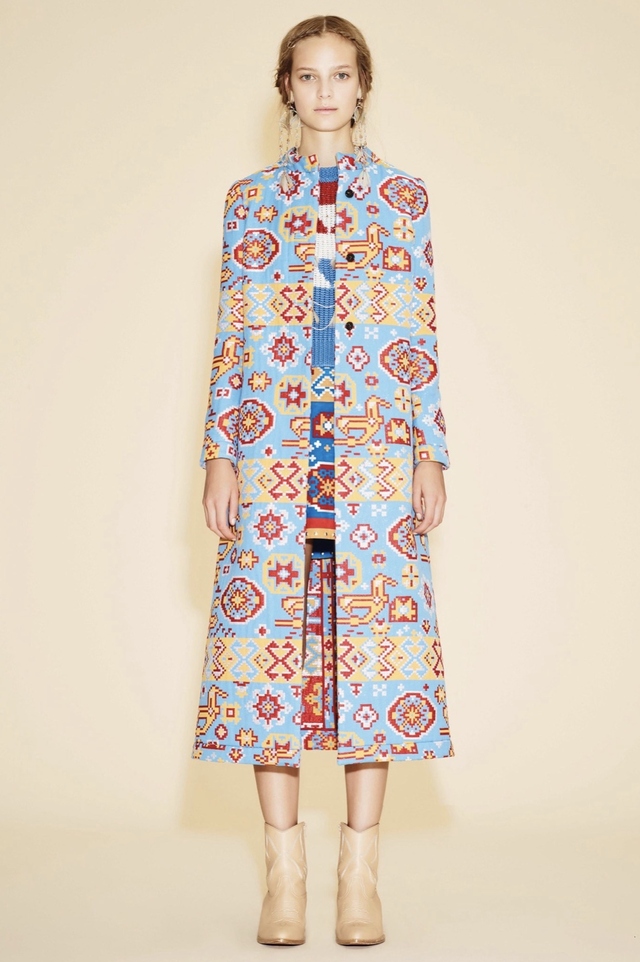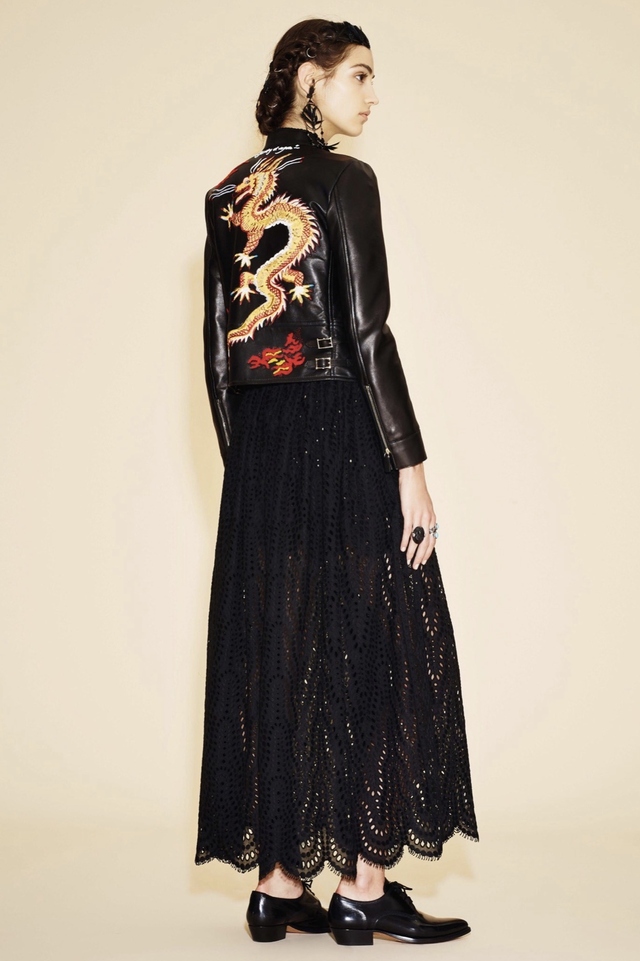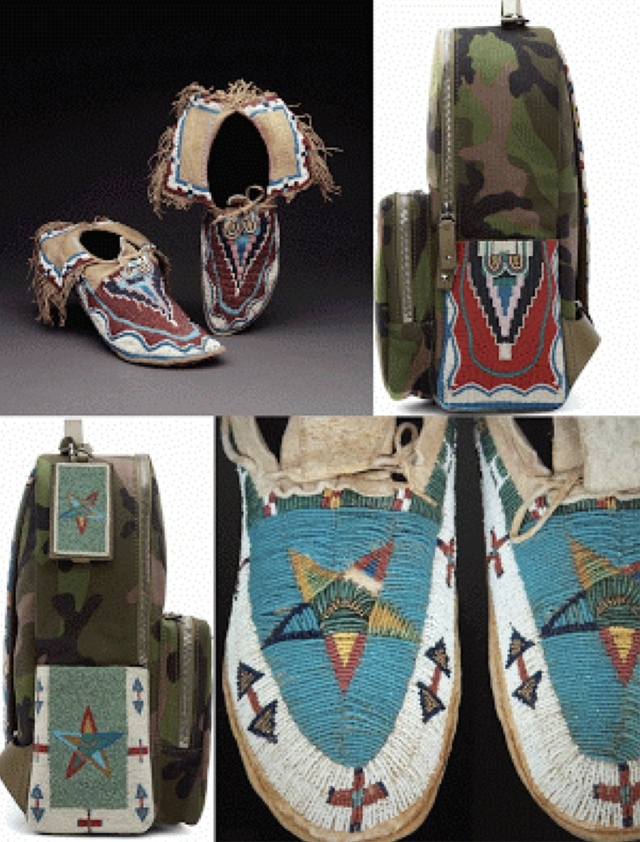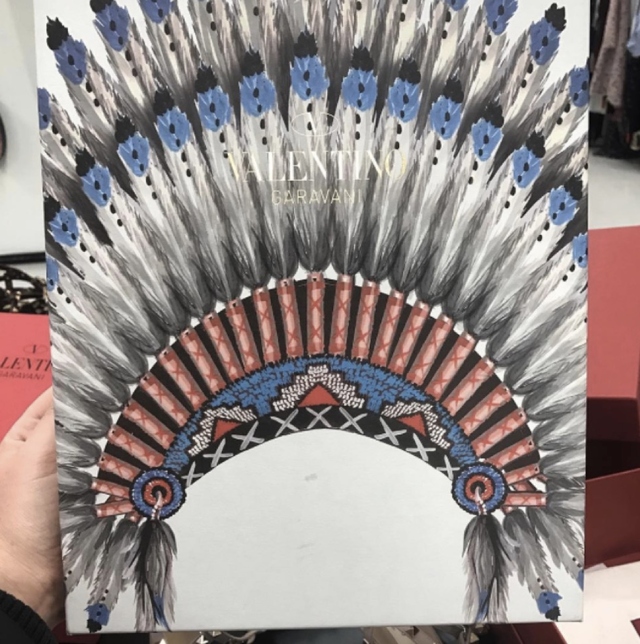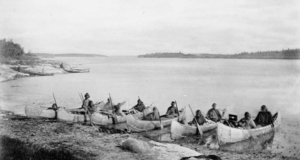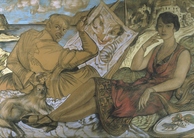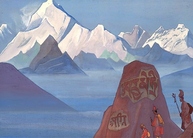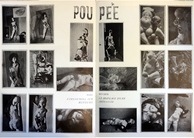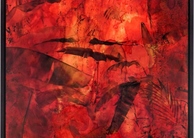Native Design in Modern Fashion: The Transformations of Native American Flower Beadwork
By
2018, Vol. 10 No. 03 | pg. 1/1
KEYWORDS:
What happens to flower beadwork when its application is transformed from traditional clothing decoration, to painting on the wall, and back to embroidery on high-end fashion garments? What happens to Native women, when their bodies are lost, violated, and heal; when their art is celebrated, stolen, and reclaimed? This paper traces the movement of Native American (particularly Métis) flower beadwork through time and space, from the traditional beadwork in moccasins in the Walking with Our Sisters project, to experimental uses in paintings such as Water Song, and eventually to the problematic appropriation by the fashion industry, including such luxury brands as Valentino. The path of unfinished moccasins offers a walk of simultaneous mourning and celebration, and its tour around North America re-appropriates the colonial route to heal the wounds of the historical past and reclaim Native identity; on the other hand, exploiting Christi Belcourt as a prop rather than a partner, and appropriating from other Native artists’ works in the name of multiculturalism, Valentino’s Resort 2016 collection is a thinly-veiled colonial catwalk that humiliates rather than heals, and that aggravates the imbalance of power instead of offering true respect and reciprocity. The history of Métis is characterized as much by oppression as by regeneration. When the French travelled to Canada in the 17th century seeking out furs, they became involved with Native women, and many decided to marry daughters of local Chiefs or other prominent members of the community in order to fully control the fur trade1. The Métis, therefore, are descendants from the unions of European men (mostly French, but also Scots and English) and Native women (Ojibwa and Cree)2. The French sometimes called them “bois brulé” (burnt sticks) because of their dark skin, while the Ojibwa called them “wesahkotewenowak,” which means “where a fire has gone through and burnt everything, new shoots are coming out of the ground.”3 Despite the Europeans’ exploitations, the Native culture was not obliterated: it adopted elements of the colonizers’ culture and combined them with its own to create a new, unique ethnic identity. The evolution of Native American beadwork and dress exemplifies this process4. The Métis in particular, developed a distinctive clothing style that exemplifies the fusion between their Native heritage and the European influence: capotes and short jackets made of hide with collars and cuffs drawn from military uniforms; lavish use of floral style decoration in porcupine quills and glass beads5. Though the flowing flower designs in Métis beadwork initially came from European wallpapers, the process of hand-making these patterns gives Métis artists a degree of agency and autonomy: they were not merely copying these designs; they took what was imposed on them and transformed it by their own hands into something idiosyncratic. Skilled makers and designers of flower beadwork - mostly women – were highly respected in the community6; they were, and still are, able to gain more economic independence and support their families through creating and selling their beadwork7. After the fire of colonization, the new shoots that came out of the ground were not only a distinctive art style, but also generations of strong, creative Métis women who were empowered, socially and financially, through artmaking.This is not to say that Métis women have ceased to suffer. In fact, according to research by the NWAC, between 2000 and 2008 alone, 153 cases of murdered Aboriginal women and girls represented approximately 10% of all female homicides in Canada, a significantly disproportionate percentage of the overall national crime rate against women8. That was why Christi Belcourt, a Métis artist, launched the Walking with Our Sisters project in 2012 to honor the missing and murdered Native women in the country. She put out a call for moccasin tops, known as “vamps,” to represent the unfinished lives of these women, and ended up receiving more over 1800 vamps, exceeding her expectation of 6009. Most of the vamps feature flowers, a motif often stereotypically associated with women, but here the association is culturally symbolic and meaningful. For example, Dolly Assinewe, a Native woman, created a pair of vamps with symmetrical images of a woman’s side profile, whose body merges with a sea of flowers10. If we see the woman on the vamp as symbolic of Native women as a whole, the curvy, twirling stems of the flowers mirror the twirling strands of the woman’s hair that flow airily, a reminder of the simultaneous vulnerability and tenacity shared by women and flowers. While a singular strand of hair or a stem might be fragile, they belong to a larger community and derive their strength therefrom. Even if you cut off all the hair of a woman, or all the stems of a plant, they will regrow with vivacious energy. Instead of going extinct, they regenerate, just like the Ojibwa name of the Métis people suggests. The strands of hair fly up towards the top of the vamp, and the stems dig deep towards the bottom, revealing the space that a woman – with her vibrant life and beauty - has the potential to conquer. This vamp therefore serves to both commemorate the loss of an individual woman’s life – missing or murdered, she no longer has the chance to fulfill this potential – and to celebrate a collective womanhood that is as beautiful, resilient and ever-present as the twirling hair strands and stems. The silver lines and dots in the woman’s hair and amongst the flowers give the whole pattern a dreamlike quality, and the woman’s closed eyes suggest both sleep and death. On the one hand, the artist laments the loss of Native women’s lives, since those who have been the missing or murdered – whose eyes are closed literally and metaphorically - can no longer see the beautiful flowers and nature that has been part of their upbringing and heritage. On the other hand, the artist perhaps wants to suggest that despite all that Native women have suffered, the flowers and the nature has become such an integral part of their lives that they will be remain as a whole regardless of actual vision, of life and death – she can still see the flowers with her eyes closed, because the flowers have become a part of her. Therefore, this vamp – as well as all vamps in this project - embodies a dual function: as a memorial11 of what this people have lost, and as a celebration of what they still have. Native Design in Modern Fashion: (left to right) Dolly Assinewe’s vamps (moccasin tops) for the Walking with Our Sisters project; Painting Water Song, by Christi Belcourt; Outfit #4 from the Valentino’s Resort 2016 Collection; Outfit #12 from the Valentino’s Resort 2016 Collection, featuring Navajo imagery; Outfit #38 from the Valentino’s Resort 2016 Collection, featuring Chinese dragon imagery; Comparison of backpack from outfit #31 from Valentino’s Spring 2016 Menswear Collection to antique Kiowa and Cheyenne moccasins; Example of a Valentino shoebox with Native war bonnets printed on top of it. In the exhibition space, the vamps were all laid out side by side to frame a path where visitors will walk barefoot. Each visitor is offered a tobacco tie to hold in the left hand, which is closest to the heart; at the end, they return the ties, which are later burned in a sacred fire. Native elders and volunteers are on hand to answer questions, or to hear visitors' impressions12. As noted by some visitors, the empty path seems almost to constitute the absent bodies which might have filled them, offering the humbling and intensely emotional experience of walking among the spirits of those lost13. The path therefore evokes a walk in solidarity with the lost Native women, but behind each pair of vamps there was also a Native woman who was alive, and who was keeping the tradition of beadwork alive. When one walks along the path, the simultaneous awareness of the lost and the living, the bringing together of the past and the present, makes this project more about healing than sheer mourning. One contributor said that her grandma used to “sit out in the sun doing her beadwork and she always said it was her medicine…It was the medicine I wanted to share, the love and healing this work represents to me.”14 No medicine can bring back the lost and the deceased, but they can heal the living, both the makers themselves and the visitors who walked amongst the vamps. The healing occurs not only on the path within a single exhibition, but also on the larger-scale path that this exhibition has travelled to in Canada and the US. In a way, this movement across many formerly colonized areas throughout North America is a reversal of the colonization process: The Métis people stem from the imposition of colonial bodies on the indigenous land (as white men married Native women), while this project places the absence of indigenous bodies (the Native women lost and murdered, epitomized by the moccasin tops without bottoms) on the colonial route, forcing us to acknowledge the imbalance of power between the First Nations people and their unwelcomed successors, both historically and in the present. Therefore, this moving exhibition symbolizes a decolonization process. Contrary to the forceful assertion of power in the colonization process, every move along the path in this project allows for complete autonomy to the areas with which it comes into contact. According to Belcourt, “artists ‘on-the-ground’ so to speak, wanted the exhibition in their community and organized with their local galleries to book it in their location…the organizing artist will be the “keeper” of the “bundle” of work when it arrives to them.”15 The concept of the “keeper” establishes the appropriate attitude when interacting with foreign cultures: don’t try to obliterate it; don’t try to steal it; instead, learn from it, and treat it with respect. There is mutual trust in the act of “keep[ing].” One vamp-maker, Tanya Kappo, describes Walking with Our Sisters as “a reclamation – a mode of rebuilding cultural ties through reconnecting with traditional forms, knowledge, and skills in danger of being lost.”16 The making of the vamps reclaims the Native heritage of beadwork, but more importantly, the project as a whole aims to reclaim the world’s recognition of First Nations people’s history and identity, as well as the mutual trust that should have been there since the very beginning. The beadwork in this project, therefore, transcends the material production to build communities around storytelling, healing, reclamation, and regeneration. While most vamps in Walking with Our Sisters are beadwork, some are embroidered or quillwork on either wool or hide; there are also a few that were weaved, painted on canvas, or even made in clay17. The experimentation with multimedia art forms in fact characterizes Christi Belcourt’s own work. She is known for using acrylic paint instead of beads to create floral designs, using the subject matter as a metaphor for human existence to convey concerns for the environment, biodiversity, spirituality and Indigenous rights18. As the Métis identity as a mixed culture was founded on synthesizing both European and Native practices, Belcourt’s work epitomizes this synthesis. Though framed paintings to hang on the wall of galleries belong to a Euro-American artistic tradition, it is part of Belcourt’s expression of agency. Taking a clichéd western artistic medium and transforming it with her own hands into something new and characteristic of both herself as an artist and her cultural heritage, this regeneration process is not unlike the origins of Métis people who took the European floral patterns and transformed it with their own hands into a distinct style of beadwork. Belcourt’s work, however, conveys much more than the decorative purposes of traditional Métis beadwork: the revitalization of knowledge. She wrote about the three distinctive threads common to Native beadwork in North America: personal and cultural/group identity, the spiritual and sacredness of imagery, and the practice as a Healing Art19. Belcourt actively listens to elders and gathers scientific information regarding the plants she harvests and paints on canvas20, so her artworks not only preserve knowledge shared by elders, but also teach younger generations about plants and their properties, reconnecting them to the land21. The healing in her art is multifold: the plants themselves are medicines; the traditional beadwork promotes healing because of the community-building process involved, such as in the case of Walking with Our Sisters; the paintings in the style of beadwork shares ecological knowledge to a broader audience in hope of healing Mother Earth. The healing works on a personal level too: Belcourt recalls a dark period in her life, during which she quit school, worked at menial jobs and took drugs, until she was befriended by a Native Elder who sparked her fascination with traditional Métis beadwork22. In a way, beadwork healed her, and now she tries to recreate the beadwork to heal more people. “My paintings are a reflection of my belief in the interconnectedness of all things within Creation,” Belcourt said in an interview, “The sacred laws of this world are of respect and reciprocity.”23 One of her most famous paintings, Water Song (2010-11), exemplifies these ideals24. The painting is mostly symmetrical, evoking the concept of reciprocity. The slight asymmetry towards the center is also carefully balanced: starting from the top, there is one more cluster of tiny U-shaped flowers on the right, one more maple leaf on the left; the long, flowy leaves on the central stem extend to varying degrees towards both sides, yet never veering far from the center. These slight deviations make the whole painting appear more naturalistic, since there is no perfect symmetry in the actual nature. They also allow viewers to perceive the beauty in the seeming randomness of the Creation, both in the sense of this work of art and of this world - random but harmonious, never arbitrary. The naturalistic depiction of plants is extremely detailed and accurate; the work features a visual lexicon of Métis botanical knowledge, including wild rose, painted trillium, blueberry, plantain, clubmoss, Indian pipe, skunk cabbage, maple, clover, and more than ten other plants25. The dark background of the painting contrasts with the bright colors of the paints, adding an element of surreal to the otherwise naturalistic scene: realistically, one would not be able to see the plants clearly at night, so the clarity of vision in this painting conveys a visionary, almost omniscient sense. One can see the ground on which plants grow, but there are also stars beneath the ground, rendering the impression that the earth here – along with all that grows on it – is floating in the universe amongst the stars. Belcourt therefore leads the audience to view this two-dimensional painting from a three-dimensional, even cosmological perspective, and experience a sense of unity between the heaven, earth, and all that is in between, including the plants and the humans, the painter and the viewers. In Belcourt’s own words, “If it is possible we live in a planet surrounded by stars, then nothing is impossible.”26 The fact that the plants are not only illuminated, but also illuminating the night reminds viewers of our limitations as human beings. If light is the source of life, Belcourt establishes these plants as not only recipients, but also givers of life. One can understand it in the sense that the oxygen produced by plants sustain the living of all animals and humans on earth – as Belcourt said, “we are at the bottom of the food chain, not the top”27 – or in terms of the interconnectedness of all, the blurring of lines between the Creator and the Creation. The visible roots of the plants recall similar roots depicted on Mimbres bowls, which similarly play with the idea of shifting perspectives because of the circular shape of the bowls’ surfaces. In Water Song, Belcourt is evoking an understanding of the universe that is beyond what the human eyes can see. “There is more to life than what is seen on the surface,” she said in her artistic statement28. And thinking back to the ideas of interconnectedness and reciprocity: if we can see the plants with such clarity, the plants can see us this clearly too; therefore, we see the transparency of our own roots through the plants’ roots, both as individuals and as cultures. Both roots need nourishment. While the paucity of water in the painting – barely visible in the two symmetrical concaves on the ground - seems contradictory to the title Water Song, Belcourt’s message perhaps exactly targets that discrepancy: the plants need so little water to survive and thrive, but even so, humans have squandered clean water to an atrocious degree. Hence the “water song” is perhaps as much an ode to water as an elegy for its loss, and most importantly, a call for all to respect the lands and the waters that nourish us. Water nourishes plants; songs nourishes human cultures. Who’s the singer of this “water song”? As Belcourt invites us to look at our roots – our cultural particularities and our shared humanity – she also celebrates the vivacity of her own culture through this picturized “song.” If one rotates the whole painting for 90 degrees, the shape of the conglomerate of plants resembles an ear. The Water Song demands listening. And someone listened. Perhaps not in the way Belcourt intended or expected, but the famed Italian fashion house Valentino contacted her for collaboration on their Resort 2016 Runway Collection. It was widely praised as a positive partnership, and Belcourt herself expressed in an interview that Valentino was “extremely respectful” and that she “couldn’t have dreamed of anything better”29. Indeed, Valentino produced splendid dresses with patterns from Water Song, outfit #4 from the collection being exemplarily exquisite30. The dress retains the symmetry of the original pattern, and the natural ruffles throughout the lower body of the dress introduce the element of asymmetry in a way that the original painting is not able to. Being hung on the wall, it is impossible for the painting to move and for the patterns to vary, while for a garment, the patterns overlap, extend, twist and transform in endless possibilities following the wearer’s movements, mirroring the movements of plants in nature in accordance to environmental circumstances. When the wind blows up the dress, the leaves and flowers will flow and dance in the wind, much like how real leaves and flowers do. The flimsy material of the dress makes these movements even more naturalistic, while the canvas gives a sense of heaviness and solemnity to the plants that emphasize their symbolic value. One significant part of this symbolic value that is lost in Valentino’s rendition is the omniscient perspective of the earth floating amongst the stars. As stars are omitted on this dress, and the transparent material fails to replicate the thick darkness of the background in the original, we lose the sense that the plants are illuminating the darkness, and the surreally clear, almost shamanic vision that comes with it. Without a distinct background, the plants on the dress seem to have been taken out of context, and lost the sense of connectedness to both the earth and the heavens. The stems of the plants overlap frequently, unlike in the painting where they are kept at balanced distances from one another; the overlapping perhaps renders a more naturalistic depiction, but at the same time the plants lose their identity as a harmonious entity, and appear as individual species competing for growth instead. The roots of the plants near the hemline of the dress seem stiff and cut-short, more like ill-drawn-and-trimmed branches than the vibrant roots digging deep into the earth in the original, hardly evocative of our cultural roots or shared humanity. The water – important despite its scarcity in the painting – is also omitted on this dress, further erasing Belcourt’s key message that Water Song tries to convey: “only if we can produce beautiful things that remind people of our responsibilities as human beings to the environment and to each other.”31Granted, Belcourt has checked Valentino’s environmental track record before the collaboration, “because the textile industry is known around the world for devastating waters and lands,” and Valentino has been rated number one by Greenpeace out of all the best-known fashion houses32. One would expect Valentino to at least honor their partner’s message within the very title of the painting they are borrowing from, and keep the water motif in more than only one of the nine pieces they collaborated on. One can argue that Belcourt has agreed to Valentino’s designs. This is true, but she was not necessarily aware of all that would happen with the design after she nodded on it. Having always been conscious of such issues as roots and heritage, Belcourt was relieved that Valentino sources most of its materials in Italy, instead of from countries that do not pay people a living wage33. The source of the material is certainly important, but what about the making process? The patterns on the dress are rendered with embroidery, which can be seen on an innovation of medium – the combination of Native traditions and western practices that Belcourt promotes. On the other hand, embroidery also recalls the origins of Métis artwork, the dark colonial past, since it was through teaching silk thread embroidery with floral images in mission schools that the flower imagery entered the Métis repertoire34. In this context, instead of adopting the embroidery skills and patterns to create their own artistic style, Métis women had no involvement in the making of the Valentino dresses. Belcourt shared in an interview how “a mother might bead something all night long just so she could sell it and maybe buy a little sugar and flour to bring home.”35 The artistic legacy of the Métis women is inseparable from their economic struggles, and it is disheartening to see that the collaboration failed to create jobs for Native American artists beyond Belcourt herself36. While it is fitting that this dress is worn by a woman and that the transparency of the material allows for the flowers to become almost indistinguishable with the woman – recalling the oneness between flower and woman in the vamps from Walking with Our Sisters – the identity of the wearer as a white woman with presumably no knowledge of the cultural and historical significance behind these flowers erases the possibility for such oneness. Instead of interconnectedness, there is dissociation, between the design and the making, between the creator and the wearer. When the sacred plants of Métis heritage are used not to celebrate the beauty of Native women but to accentuate the allure of a near-naked white woman of the colonial culture, the runway where these dresses were presented offers a not path of healing, but a path of humiliation. After the runway show, the costumers of these dresses are most likely to be of similar backgrounds as the model than as the Native people at the source of these designs: rich middle-age white women. Some of these garments can also be seen in the January 2016 issue of Marie Claire Italia and the December/January 2016 edition of Teen Vogue, paired with a fashion editorial “Into the Wild” that focuses on layering on “ground-grazing dresses” for the winter37. Belcourt’s Water Song, with all its cultural and ecological significance, as well as a whole history of Métis flower beadwork, are therefore reduced to a measure of its length (“ground-grazing”) and an inaccurate, condescending label as “the Wild.” Even just looking at the collection itself, it turns about that the widely praised collaboration with Belcourt only produces 9 out of the 82 pieces in the collection, and a number of the rest of the pieces appropriated patterns from other cultures, including the Navajos (in outfits #12, 13, and 14)38 and the Chinese (in outfits #19 and 38)39. I here use the definition of cultural appropriation “as the taking – from a culture that is not one’s own – of intellectual property, cultural expressions or artifacts, history and ways of knowledge”40. In this process, one must also take into account of the inherent inequality in many cultural transactions41. As one of the First Nations peoples in the US, the Navajos had been victims of persecution42, with a painful history not unlike that of the Métis in Canada. However, all Native cultures are distinct – in fact, there was no Native identity prior to contact with the Europeans, as all indigenous people identified themselves as members of their own nations instead43. Therefore, the fact that Belcourt agreed to share her art does not mean that all other Native tribes have agreed to the same. Valentino’s appropriation of Navajo patterns shows either an ignorance in treating all Natives as one monolithic entity, or a scheme by exploiting Belcourt as a token minority, a prop rather than a partner. Valentino’s use of dragons to represent China also reveals a colonial mindset that reduces the complex and vibrant Chinese culture to a stereotypical exotic myth. If these do not amount to cultural appropriation, there are cases where Native patterns were blatantly copied. In Valentino’s Spring 2016 Menswear Collection – the counterpart of the Resort collection that features Belcourt’s work - a Valentino backpack (from outfit #31) embellished with Native American beadwork designs directly copied from antique Kiowa and Cheyenne moccasins44. The fact that the moccasins were gathered from places of exclusivity – one curated in an antique art exhibition45, the other on sale at a gallery for $450046 – exploits the fact that Native people are very unlikely to visit these sites and discover this appropriation. The lack of exposure does not legitimatize Valentino’s plagiarism; instead, it highlights Valentino’s self-proclaimed high status in relation to the cultures it stole from, and establishes an image of the fashion house as a neo-colonial power. More atrocious was Valentino’s placement of Native war bonnet patterns on “limited edition” shoeboxes soon after the collaboration with Belcourt47. War bonnets were given to members in Great Plains societies as recognition for a great accomplishment, and was worn in ceremonies and other formal occasions such as nation-to-nation meetings48. For a headdress of honor and tradition to be printed on top of shoeboxes, to hold and to be trampled by European-style stilettos, is offensive to say the least. The colonial stilettos in this context stands in direct opposition to the moccasins in Walking with Our Sisters: both for women, the latter celebrate Native identity, the former crush it; the latter walk a metaphorical path of decolonization, the former recolonize. It is therefore ironic to read that this collection was inspired by Parisian fashion editor Diana Vreeland’s motto: “The eye has to travel.”49 For Valentino, travel is a euphemism for colonization, as it represents non-European cultures as mythical, exotic, simplistic, and unworthy of true respect or understanding50. The concept of multiculturalism that Valentino’s creative director Maria Grazia Chiuri uses to ground this collection is no less problematic. “Cultures become one culture – that’s what we find exciting,” said Chiuri, “At the end there is no real reference.”51 The dangerous mentality - that there is no such thing as appropriation if one appropriate from every culture - underlies the history of colonialism and its present manifestation on the colonial catwalks. It is time to look back to the source, to find beauty in such simple flower beadwork as the moccasin tops, to listen to the songs of the water and of the people, to support native designers, and to move through time, space, and cultures with respect and a sense of connectedness. Only then will we be able to truly heal and regenerate. References“A Commemorative Art Installation for the Missing and Murdered Indigenous Women of Canada and the United States.” Walking with Our Sisters. Accessed May 16, 2017. http://walkingwithoursisters.ca/about/. Anderson, Stephanie G. “Stitching through Silence: Walking with our Sisters, Honoring the Missing and Murdered Aboriginal Women in Canada.”Textile14, no. 1 (2016): 84-96. Belcourt, Christi. “Artistic Statement.” Christibelcourt.com. Accessed May 16, 2017. http://christibelcourt.com/artist-statement/ ---. “About My Art.” Biodiversity, 3:3, 7-7 (2002): 7. DOI: 10.1080/14888386.2002.9712585 ---. Beadwork: First People’s Beading History and Techniques. Ontario: Ningwakwe Learning Press, 2010. ---, Rita Flamand, Olive Whitford, and Rose Richardson. Medicines to Help Us: Traditional Métis Plant Use: Study Prints and Resource Guide. Saskatchewan: Gabriel Dumont Institute of Native Studies & Applied Research, 2007. Beckwith, Spencer. “A Curation of Antique Art from Indian Country.” KUNM. August 11, 2016. Accessed May 16, 2017. http://kunm.org/post/curation-antique-art-indian-country. Bell, Gloria. “Interview with Christi Belcourt, Contributing Artist and Coordinator for Walking with Our Sisters.” Aboriginal Curatorial Collective. Accessed May 16, 2017. http://www.acc-cca.com/wordpress/research-page/podcasts/interview-with-christi-belcourt-contributing-artist-and-coordinator-for-walking-with-our-sisters/. Birchfield, D. L. “Navajos.” Countries and Their Cultures Forum. Accessed May 16, 2017. http://www.everyculture.com/multi/Le-Pa/Navajos.html. Campione, Chiara. “In Fashion Duel, Valentino proves 'Green' really is the new ‘Black.’” Greenpeace International. February 7, 2013. Accessed May 16, 2017. http://www.greenpeace.org/international/en/news/Blogs/makingwaves/fashion-duel/blog/43909/. Chinn, Jennie, Joy Harnett, Bobbie Pray, Rick Schmidt, and Barry Worley. Traditions: Native American Beadwork. Kansas: Kansas State Historical Society, 1993. Accessed May 16, 2017. https://www.kshs.org/kansapedia/pdfs/traditions_native_american_beadwork.pdf. “Collections.” Valentino. Accessed May 16, 2017. https://www.valentino.com/experience/us/maison/collections. Craik, Jennifer.The Face of Fashion: Cultural Studies In Fashion.London: Routledge, 1994. Edge, Lois, and Tom McCallum. “Métis Identity: Sharing Traditional Knowledge and Healing Practices at Métis Elders’ Gatherings.”Pimatisiwin: A Journal of Aboriginal and Indigenous Community Health4, no. 2 (2006): 84-115. Accessed May 16, 2017. http://www.pimatisiwin.com/uploads/1399918655.pdf. Everett-Green, Robert. “Métis Artist Christi Belcourt Inspires Valentino Fashion Line." The Globe and Mail. August 04, 2015. Accessed May 16, 2017. http://www.theglobeandmail.com/arts/art-and-architecture/metis-artist-christi-belcourt-inspires-valentino-fashion-line/article25824113/. “Fact Sheet: Missing and Murdered Aboriginal Women and Girls.” National Women’s Association of Canada. March 31, 2010. Accessed May 16, 2017. https://nwac.ca/wp-content/uploads/2015/05/Fact_Sheet_Missing_and_Murdered_Aboriginal_Women_and_Girls. “Floral Beadwork: A Métis Cultural Heritage to Rediscover.” Encyclopédie du patrimoine culturel de l'Amérique française – histoire, culture, religion, héritage. December 15, 2008. Accessed May 16, 2017. http://www.ameriquefrancaise.org/en/article-476/Floral_Beadwork:_A_Métis_Cultural_Heritage_to_Rediscover_.html. Holmes, Kelly. “Native Art Spotted: First Nations Artist’s Collab with Valentino in Teen Vogue, Marie Claire Italia.” Native Max Magazine. January 4, 2016. Accessed May 16, 2017. https://nativemaxmagazine.com/native-art-spotted-first-nations-artists-collab-with-valentino-in-teen-vogue-marie-claire-italia/. K., Adrienne. “Valentino Didn’t Learn Anything.” Native Appropriations. March 23, 2017. Accessed May 16, 2017. http://nativeappropriations.com/2017/03/valentino-didnt-learn-anything.html. Kappo, Tara. “Project Description.” Walking with Our Sisters. Accessed May 16, 2017. http://walkingwithoursisters.ca/art/tara-kappo/. Kermoal, Nathalie J., and Isabel Altamirano-Jiménez.Living On the Land: Indigenous Women's Understanding of Place. Athabasca: Athabasca University Press,2016. Klein, Alyssa Vingan. “Chanel Shows Controversial Native American Headdresses for Pre-Fall.” Fashionista. December 11, 2013. Accessed May 16, 2017. http://fashionista.com/2013/12/chanel-shows-native-american-headdresses. Leitch, Luke. “Valentino Spring 2016 Menswear Fashion Show.” Vogue. June 24, 2015. Accessed May 16, 2017. http://www.vogue.com/fashion-shows/spring-2016-menswear/valentino. Metcalfe, Jessica R. “Oh No, Valentino | Appropriation and the Case of the Stolen Beadwork.” Beyond Buckskin. April 25, 2017. Accessed May 16, 2017. http://www.beyondbuckskin.com/2017/04/oh-no-valentino-appropriation-and-case.html. “Métis Textiles.” Museum of Natural and Cultural History. Accessed May 16, 2017. http://natural-history.uoregon.edu/collections/web-galleries/metis-textiles. “Moccasins, Cheyenne, circa 1890.” David Cook Galleries. Accessed May 16, 2017. http://www.davidcookgalleries.com/american-indian/17381. Morin, Brandi. “Canadian Metis Artist Collaborates with Fashion Powerhouse Valentino for 2016 Collection.” APTN National News. June 30, 2015. Accessed May 16, 2017. http://aptnnews.ca/2015/06/30/canadian-metis-artist-collaborates-fashion-powerhouse-valentino-2016-collection/. Penney, David W.North American Indian Art.London: Thames & Hudson, 2004. Public Policy Forum. “Christi Belcourt: Visual Artist and Author.” Canada Business Network. Accessed May 16, 2017. http://canadabusiness.ca/success-stories/christi-belcourt/. Rynor, Becky. “From the Heart: An Interview with Christi Belcourt.” NGC Magazine. October 2, 2015. Accessed May 16, 2017. http://www.ngcmagazine.ca/artists/from-the-heart-an-interview-with-christi-belcourt. Schneider, Arnd. “On ‘Appropriation’: A Critical Reappraisal of the Concept and its Application in Global Art Practices.”Social Anthropology11, no. 2 (2003): 215-229. Shaughnessy, Jonathan. “The “World” of Contemporary Gallery B104.” NGC Magazine. December 14, 2016. Accessed May 16, 2017. http://www.ngcmagazine.ca/exhibitions/the-world-of-contemporary-gallery-b104. Tsosie, Rebecca. “Reclaiming Native Stories: An Essay on Cultural Appropriation and Cultural Rights.”Arizona State Law Journal34, no. 1 (2002): 299. Turra, Alessandra. “Valentino Resort 2016 Review.” Women’s Wear Daily. June 16, 2015. Accessed May 16, 2017. http://wwd.com/runway/resort-2016/milan/valentino/review/. Weaver, Hilary N. “Indigenous Identity: What is it, and Who really has it?”American Indian Quarterly25, no. 2 (2001): 240-255. Endnotes1.) Lois Edge and Tom McCallum, “Métis Identity: Sharing Traditional Knowledge and Healing Practices at Métis Elders’ Gatherings,” Pimatisiwin: A Journal of Aboriginal and Indigenous Community Health4, no. 2 (2006): 90, accessed May 16, 2017, http://www.pimatisiwin.com/uploads/1399918655.pdf. 2.) David W. Penney, North American Indian Art (London: Thames & Hudson, 2004): 186. 3.) Edge and McCallum, “Métis Identity: Sharing Traditional Knowledge and Healing Practices at Métis Elders’ Gatherings,” 91. 4.) As none had metal tools, the construction of beads before the Europeans’ arrival was a long process. Using stone or wood and abrasives such as sand, Native artists made beads that were relatively large, worn strung on necklaces or decorating clothing made from buffalo skins. After trading with the Europeans, however, Native Americans soon realized the possibilities created by the availability of small, brightly colored glass beads, and started adorning clothes with them despite the change of clothing materials and styles. They also adopted a technique called raised or couched stitch for flower beadwork: more beads are strung on a thread than can be sewn flat on the material, and form a small arc when the thread is drawn tight. Since the arcs don’t lie flat, there is a three-dimensional effect. For more on Métis beadwork, see Jennie Chinn et al., Traditions: Native American Beadwork (Kansas: Kansas State Historical Society, 1993): 1-5, accessed May 16, 2017, https://www.kshs.org/kansapedia/pdfs/traditions_native_american_beadwork.pdf. 5.) Penney, North American Indian Art, 187. 6.) “Métis Textiles,” Museum of Natural and Cultural History, accessed May 16, 2017, http://natural-history.uoregon.edu/collections/web-galleries/metis-textiles. 7.) “Floral Beadwork: A Métis Cultural Heritage to Rediscover,” Encyclopédie du patrimoine culturel de l'Amérique française, December 15, 2008, accessed May 16, 2017, http://www.ameriquefrancaise.org/en/article-476/Floral_Beadwork:_A_Métis_Cultural_Heritage_to_Rediscover_.html. 8.) “Fact Sheet: Missing and Murdered Aboriginal Women and Girls,” National Women’s Association of Canada, March 31, 2010, accessed May 16, 2017, https://nwac.ca/wp-content/uploads/2015/05/Fact_Sheet_Missing_and_Murdered_Aboriginal_Women_and_Girls. 9.) “A Commemorative Art Installation for the Missing and Murdered Indigenous Women of Canada and the United States,” Walking with Our Sisters, accessed May 16, 2017, http://walkingwithoursisters.ca/about/. 10.) See attached picture #1. 11.) According to Christi Belcourt, “[Walking with Our Sisters] is not really an art exhibit, it’s a memorial.” See Robert Everett-Green, “Métis Artist Christi Belcourt Inspires Valentino Fashion Line,” The Globe and Mail, August 04, 2015, accessed May 16, 2017, http://www.theglobeandmail.com/arts/art-and-architecture/metis-artist-christi-belcourt-inspires-valentino-fashion-line/article25824113/. 12.) Gloria Bell, “Interview with Christi Belcourt, Contributing Artist and Coordinator for Walking with Our Sisters,” Aboriginal Curatorial Collective, accessed May 16, 2017, http://www.acc-cca.com/wordpress/research-page/podcasts/interview-with-christi-belcourt-contributing-artist-and-coordinator-for-walking-with-our-sisters/. 13.) Stephanie G. Anderson, “Stitching through Silence: Walking with our Sisters, Honoring the Missing and Murdered Aboriginal Women in Canada,”Textile14, no. 1 (2016): 89. 14.) Tara Kappo, “Project Description,” Walking with Our Sisters, accessed May 16, 2017, http://walkingwithoursisters.ca/art/tara-kappo/. 15.) Bell, “Interview with Christi Belcourt, Contributing Artist and Coordinator for Walking with Our Sisters.” 16.) Anderson, “Stitching through Silence: Walking with our Sisters, Honoring the Missing and Murdered Aboriginal Women in Canada,”94. 17.) Bell, “Interview with Christi Belcourt, Contributing Artist and Coordinator for Walking with Our Sisters.” 18.) Public Policy Forum, “Christi Belcourt: Visual Artist and Author,” Canada Business Network, accessed May 16, 2017, http://canadabusiness.ca/success-stories/christi-belcourt/. 19.) Christi Belcourt, Beadwork: First People’s Beading History and Techniques (Ontario: Ningwakwe Learning Press, 2010), 12. 20.) Nathalie J. Kermoal and Isabel Altamirano-Jiménez,Living On the Land: Indigenous Women's Understanding of Place (Athabasca: Athabasca University Press,2016), 131. 21.) Christi Belcourt et al., Medicines to Help Us: Traditional Métis Plant Use: Study Prints and Resource Guide (Saskatchewan: Gabriel Dumont Institute of Native Studies & Applied Research, 2007), 25. 22.) Becky Rynor, “From the Heart: An Interview with Christi Belcourt,” NGC Magazine, October 2, 2015, accessed May 16, 2017, http://www.ngcmagazine.ca/artists/from-the-heart-an-interview-with-christi-belcourt. 23.) Christi Belcourt, “About My Art,” Biodiversity, 3:3, 7-7 (2002): 7, DOI: 10.1080/14888386.2002.9712585. 24.) See attached picture #2. 25.) Jonathan Shaughnessy, “The “World” of Contemporary Gallery B104,” NGC Magazine, December 14, 2016, accessed May 16, 2017, http://www.ngcmagazine.ca/exhibitions/the-world-of-contemporary-gallery-b104. 26.) Christi Belcourt, “Artistic Statement,” accessed May 16, 2017, http://christibelcourt.com/artist-statement/. 27.) Ibid. 28.) Christi Belcourt, “About My Art.” 29.) Everett-Green, “Métis Artist Christi Belcourt Inspires Valentino Fashion Line.” 30.) See attached picture #3. 31.) Brandi Morin, “Canadian Metis Artist Collaborates with Fashion Powerhouse Valentino for 2016 Collection,” APTN National News, June 30, 2015, accessed May 16, 2017, http://aptnnews.ca/2015/06/30/canadian-metis-artist-collaborates-fashion-powerhouse-valentino-2016-collection/. 32.) Chiara Campione, “In Fashion Duel, Valentino proves 'Green' really is the new ‘Black,’” Greenpeace International, February 7, 2013, accessed May 16, 2017. http://www.greenpeace.org/international/en/news/Blogs/makingwaves/fashion-duel/blog/43909/. 33.) Everett-Green, “Métis Artist Christi Belcourt Inspires Valentino Fashion Line.” 34.) Penney, North American Indian Art, 187. 35.) Rynor, “From the Heart: An Interview with Christi Belcourt.” 36.) Amongst Valentino’s collections, only the Haute Couture collections are hand-made (by a team of about 60 specialized seamstresses in Rome); the rest, including this Resort collection, were machine-made. While there is no direct evidence, based on conventional understanding, the pieces in this collection were most likely made in factories in developing countries. It is extremely unlikely that any Native artist will be part of the production process. For the Valentino’s various collections, see “Collections,” Valentino, accessed May 16, 2017, https://www.valentino.com/experience/us/maison/collections. 37.) Kelly Holmes, “Native Art Spotted: First Nations Artist’s Collab with Valentino in Teen Vogue, Marie Claire Italia,” Native Max Magazine, January 4, 2016, accessed May 16, 2017, https://nativemaxmagazine.com/native-art-spotted-first-nations-artists-collab-with-valentino-in-teen-vogue-marie-claire-italia/. 38.) See attached picture #4 as an example. 39.) See attached picture #5 as an example. 40.) Rebecca Tsosie, “Reclaiming Native Stories: An Essay on Cultural Appropriation and Cultural Rights,” Arizona State Law Journal34, no. 1 (2002): 299. 41.) Arnd Schneider, “On ‘Appropriation’: A Critical Reappraisal of the Concept and its Application in Global Art Practices,”Social Anthropology11, no. 2 (2003): 215-229. 42.) The US Army took away Navajo homeland by force in 1864. Half of the Navajos, demoralized and starving, surrendered to the army and were marched 370 miles to the Bosque Redondo concentration camp on the Pecos River, where many died. After four years of imprisonment, they were allowed to return to their homeland, nowreduced to one-tenth its original size. For more on Navojo culture and history, see D. L. Birchfield, “Navajos,” Countries and Their Cultures Forum, accessed May 16, 2017, http://www.everyculture.com/multi/Le-Pa/Navajos.html. 43.) Hilary N. Weaver, “Indigenous Identity: What is it, and Who really has it?,”American Indian Quarterly25, no. 2 (2001): 240-255. 44.) For a comparison of these works, see attached picture #6. Jessica R. Metcalfe, “Oh No, Valentino | Appropriation and the Case of the Stolen Beadwork,” Beyond Buckskin, April 25, 2017, accessed May 16, 2017, http://www.beyondbuckskin.com/2017/04/oh-no-valentino-appropriation-and-case.html. 45.) Spencer Beckwith, “A Curation of Antique Art from Indian Country,” KUNM, August 11, 2016, accessed May 16, 2017, http://kunm.org/post/curation-antique-art-indian-country. 46.) “Moccasins, Cheyenne, circa 1890,” David Cook Galleries, accessed May 16, 2017, http://www.davidcookgalleries.com/american-indian/17381. 47.) See attached picture #7 for an example. Adrienne K., “Valentino Didn’t Learn Anything.,” Native Appropriations, March 23, 2017, accessed May 16, 2017, http://nativeappropriations.com/2017/03/valentino-didnt-learn-anything.html. 48.) The Great Plains peoples include the Sioux, Crow, Blackfeet, Cheyenne, and Plains Cree. One’s accomplishments to earn a war bonnet can be in war, diplomacy, and/or leadership. It is extremely unlikely that a woman would ever own or wear a war bonnet. For more about the historical and cultural significance of war bonnets, see Alyssa Vingan Klein, “Chanel Shows Controversial Native American Headdresses for Pre-Fall,” Fashionista, December 11, 2013, accessed May 16, 2017, http://fashionista.com/2013/12/chanel-shows-native-american-headdresses. 49.) Alessandra Turra, “Valentino Resort 2016 Review,” Women’s Wear Daily, June 16, 2015, accessed May 16, 2017, http://wwd.com/runway/resort-2016/milan/valentino/review/. 50.) The idea that non-western dress does not change is central to establishing its difference from western fashion, which is predicated on regular and arbitrary changes and projects individual identity (which non-western dress supposedly lacks). See Jennifer Craik, The Face of Fashion: Cultural Studies In Fashion (London: Routledge, 1994): 168. 51.) Luke Leitch, “Valentino Spring 2016 Menswear Fashion Show,” Vogue, June 24, 2015, accessed May 16, 2017, http://www.vogue.com/fashion-shows/spring-2016-menswear/valentino. Suggested Reading from Inquiries Journal
Inquiries Journal provides undergraduate and graduate students around the world a platform for the wide dissemination of academic work over a range of core disciplines. Representing the work of students from hundreds of institutions around the globe, Inquiries Journal's large database of academic articles is completely free. Learn more | Blog | Submit Latest in Visual Arts |

